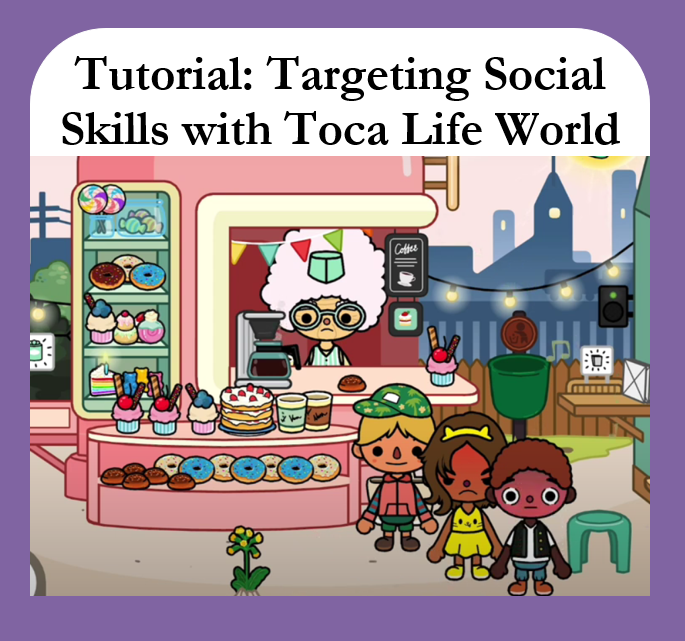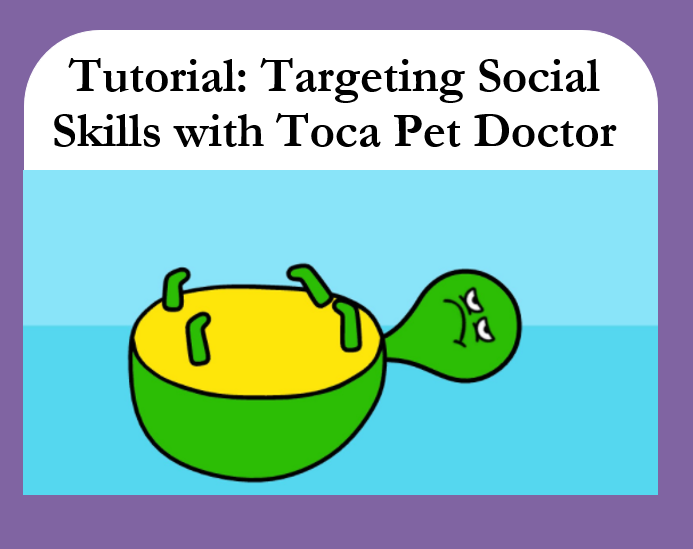Flexible and resilient thinking is all about problem-solving our inevitable struggles. I’m sharing my efforts to find solutions to my struggles in case any other SLPs find them helpful.
Toca Life World for Social Skills
As children with social skills deficits try to navigate our highly-social world they must first learn the basics (eye contact, following eye-gaze, attending to others, etc.) and then learn to use those skills to identify others’ emotions, inference the cause of the emotions, and problem-solve the situations causing these emotions. To target these skills during play-based activities (which are always my preference both because they increase generalization and they keep children motivated and participating) I’ve been using two apps lately.

The first app I’ve been using is Toca Life World (which is free). When I first read a blog about using it for speech-langauge pathology my first thought was: “I could make my own social scenes!” I had so many patients who had memorized the dozens of social scenes in my clinic and I needed a fast way to make new ones with novel social situations. I quickly found that Toca Life World can be used to create social scenes “on-the-fly” or in advance. Here’s my tutorial on how I’ve been doing both.
Toca Pet Doctor for Social Skills
I also found that Toca Pet Doctor (which costs $3.99) is great for working on these social skills! Here’s my tutorial on how I’ve been using it with more details on the least-to-most cueing hierarchy I use when I’m targeting these skills.

A special note: When inferencing the cause of emotions I prefer to ask “what made him feel sad?” rather than “why does he feel sad?” I find if I use the latter question the kids often tell me, “because he’s crying.”
Another special note: I love the Zones of Regulation and combining the framework of it while working on these skills!
On another topic, am I the only SLP disinfecting the treatment room floor?

Even if I am I can’t stop with a clear conscience. I’ve always disinfected my floors (even before COVID-19). Before the pandemic I used Lysol concentrate for this job and now I use Cavicide. I have several reasons for this…
- Some children work best when they’re sitting on the floor. The Occupational Therapists I’ve worked with would have an explanation that has something to do with core strength and proprioception, but I’ll let you find something written by one of them about it because it’s not my area of expertise.
- Some of my patients are young enough to eat off the floor. A couple of my patients are under the age of 3, a couple are cognitively under that age, and a couple suffer from severe impulsivity. Anyone who doesn’t work with kids would be surprised at how fast they can be and they aren’t always able to respond to “no” or “stop.” Due to this, I sweep my floor every morning and keep an eye on the floor between appointments, but bits have still slipped past me despite my best efforts.
- Some of my patients are working on saliva management. This is an inevitable part of being a speech-langauge pathologist. Some of my patients struggle with the physical and cognitive mechanisms that most of us use to keep ourselves from drooling. This means it’s not uncommon for drops of saliva to be on my floor. I always disinfect the floors after patients who are struggling with these areas.
- Many droplets from coughing, sneezing, and talking end up on the floor. Back when I was aspiring to be an epidemiologist I was fascinated by the unexpectedly germ-ridden places such as sink basins and the floor. For the floor, this happens because even when wearing masks or coughing into our sleeves we will have escaped droplets. These usually get pulled to the floor by gravity.
- Some of my patients work best in bare feet. I don’t know if there’s an Occupational Therapy explanation for this one and maybe it’s because we live in a dry desert. Regardless, I learned the hard way that my bubble-friendly floors are too slippery for kids to wear regular socks.
